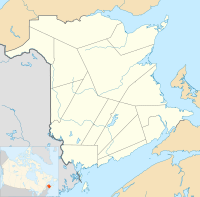Eskɨnuopitijk or Esgenoôpetitj [2] ( Burnt Church Band or Burnt Church First Nation ) is a Mi'kmaq First Nation band government in New Brunswick, Canada, centred south of the community of Lagacéville (approximately 4.5 km) and southwest of the village of Neguac (approximately 7 km) on Miramichi Bay. It covers two Indian reserves in Northumberland County (Esgenoôpetitj 14, previously Burnt Church 14, and Tabusintac 9) and two reserves in Gloucester County (Pokemouche 13) (Pabineau).[3] The population was 1,715 as of 2011. The Mi'kmaq call Burnt Church Esgenoôpetitj, which means "a lookout".[4]
Esgenoôpetitj (Burnt Church) | |
|---|---|
Location of Esgenoôpetitj (Burnt Church) in New Brunswick | |
| Coordinates: 47°11′52.5″N 65°08′53.7″W / 47.197917°N 65.148250°W | |
| Country | Canada |
| Province | New Brunswick |
| County | Northumberland County |
| Established | 1802 |
| Government | |
| • Chief | Alvery Paul |
| • Council | List of Members
|
| • MP | Jake Stewart (CPC) |
| • Provincial Representatives | Réjean Savoie (PC) |
| Area | |
| • Total | 44.055 km2 (17.010 sq mi) |
| Lowest elevation | 0 m (0 ft) |
| Population (2011)[1] | |
| • Total | 1,715 |
| Time zone | UTC-4 (Atlantic (AST)) |
| • Summer (DST) | UTC-3 (ADT) |
| NTS Map | 21P3 Chatham |
| Postal code span: | |
History
editThe land has been inhabited by First Nations peoples since at least 1727, when a map by Sieur l'Hermitte recorded it.[5]
William Francis Ganong explained that the current name arose after the 1758 Gulf of St. Lawrence Campaign (1758), when British General James Wolfe directed Colonel James Murray to destroy the Acadian settlements of Miramichi which including burning the stone church.
Burnt Church was included in one of the very earliest Indian reserves set aside by New Brunswick. The reserve was officially established March 5, 1805, with 2,058 acres (8.33 km2). At the time of Ganong's writing it was "still a favorite Micmac settlement, and much the largest in all New Brunswick".[5]
Following the Seven Years' War, several Acadian families returned to lands adjoining the reserve. They were followed by a wave of new Scottish settlers. Thus, the Burnt Church name is now used in reference to both the local First Nation, and to the adjoining non-native community.
In recent years, Burnt Church First Nation members have fought strenuously for their traditional lobster fishing rights, culminating in the Burnt Church Crisis with the provincial and federal governments as well as local non-native fishermen.[6]
Notable people
editSee also
editReferences
edit- ^ Indian and Northern Affairs, retrieved February 2, 2009.
- ^ Site of Burnt Church Archived February 21, 2016, at the Wayback Machine
- ^ Inac.gc.ca First Nation Detail page
- ^ Rand, Silas Tertius (1875-01-01). A First Reading Book in the Micmac Language: Comprising the Micmac Numerals, and the Names of the Different Kinds of Beasts, Birds, Fishes, Trees, &c. of the Maritime Provinces of Canada. Also, Some of the Indian Names of Places, and Many Familiar Words and Phrases, Translated Literally Into English. Nova Scotia Printing Company.
- ^ a b The History of Neguac and Burnt Church Archived December 19, 2009, at the Wayback Machine, retrieved August 30, 2008
- ^ The Marshall Decision and the Maritime Canadian Fishery Archived 2009-03-05 at the Wayback Machine, retrieved August 30, 2008
